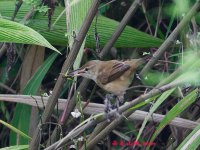I have tried to summarize the details of the bird based on one picture and some of things are said possibly earlier in the former posts. Sorry fellows, if this looks so long !

This is not some perfect or a final list on this case, but I have tried to write today's impression from this bird to this post. Also some of you may disagree my description, at least partly, but it’s natural.
Th_SQ and Jane have considered earlier that this can be a small Acro. I’d like to add that we have to keep in mind also that option. Maybe both the eye and the size of the bill may favor more on small Acro! But I don’t want yet to dig down a large Acro –option.
The plumage is comparatively fresh, which indicate that this bird is juvenile, because photo is taken in the beginning of October.
The colour of the upperparts (mantle, back, rump) is rather dark; resemble somehow fresh European Reed Warbler, however being richer colouration than above species. General colour is warm brown with rusty /ochre tinge and some greyish tinge in the neck / nape area. It’s good to notice that the weather is not sunny, but cloudy in the time of photographing.
The colour of the underparts is pale, next to whitish (?) with quite widespread ochre-brownish tinge, especially located in the flanks and vent. Throat looks quite dirty whitish.
In October, the bill is probably almost full-grown, which gives us a quite real impact on the jizz of bird. But because bill is open, it’s rather difficult to compare both the length and the width of the bill to each other. But bill is at least medium length, and it doesn't look so long as usually in Clamorous or Oriental in the pictures. Lower mandible is wholly pale and upper mandible wholly dark, which is quite similar as in European Reed Warbler. The colour of lower mandible may refer to the fact that the species is some other than a large Acro.
The border between the supercilium and the forehead is quite distinct in this bird, the supercilium continues quite distinctly to above eye and maybe less distinctly beyond (probably it even lack beyond). Also bird has a short loral stripe. Jane suggested that the eye looks relatively larger in the case than in one Clamorous Reed Warbler, but I’m not so convinced on that conclusion. The Clamorous’s eye is relatively more amidst and it’s shape is maybe more circular (?). Forehead looks slightly darker than crown and it point out the supercilium in the front of the eye.
The primaries are quite dark, almost blackish, and nearly similar as in Marsh Warbler and there is some contrast between primaries and tail feathers. The primaries are finely but clearly tipped whitish as in Marsh Warbler. The tertials are also quite dark, slightly paler than primaries, dark brown.
The edges of greater coverts and tertials, and also the outer edges of the secondaries and the primaries have clear and distinct warm (rusty) brown edges. Especially the edges of greater coverts are widely coloured than other parts of the wing. The outer edges forming some wing panel to the secondaries.
I’m sure that the longest tertial is longer than secondaries. There are 5-6 primary tips in visible beyond the longest tertial. I suppose that the primary projection is quite short, clearly shorter than the length of tertials.
There is possibly only one weak emargination on p9 or p8. The top of wing is possibly P8. Legs are quite dark too.
After all, I have always difficulties to specify tinges correctly. I think that most people in this forum own better sense of colour. :t:




